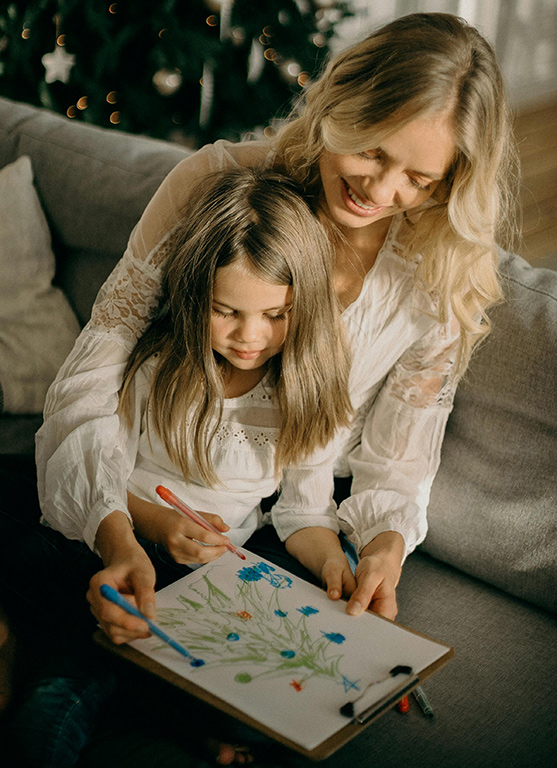by Cady Andersson
What exactly is considered money in your emotional bank account when it comes to relationships?
As a teacher we are taught that no learning (and I mean absolutely no learning) happens outside of a warm, positive relationship. We cannot learn if we are scared we aren’t loved, appreciated, or understood by important people in our lives. Thus as caregivers, we need a baseline of a positive, warm relationship to be able to guide or encourage young children to learn from us. So how do we do that?

Quality Time
The first and most important thing you can do, especially if the child is showing you undesirable behavior, is spend more quality time with them. Positive Quality Time. It is the most annoying advice we give at parent-teacher conferences. Parents will say “Shana is throwing all kinds of crazy temper tantrums at home. She is totally disrespectful and destroying things.”
Then they hear this irritating response from me and many other trained early childhood professionals: “Have you tried spending more quality time together? Oftentimes, when children are acting out at home, the child needs more positive, one-on-one, relationship-building time. Maybe you could try making a list of things you all would like to do together and let the child pick one each week. We often suggest ignoring the undesirable behavior and acknowledging the behavior you wish to reinforce. In this way a positive adult-child relationship can be built so that your interactions are more positive than negative.
If you try to correct your child before you connect with your child, it is like going to the bank and trying to withdraw money (expecting a child to clean up after a cereal throwing debacle at the grocery store) and finding that you haven’t deposited any money (positive experiences where the child feels you like/love/value/see/appreciate/understand them) in quite a while. Your relationship “bank teller” might say something like: “Gosh, it looks like your emotional bank account has a negative balance. I see your last 10 transactions were withdrawals. Yes, in fact, it says that yesterday at lunch there was a demand to eat a certain food at the table that resulted in a power struggle. And before that it was a loud, ‘Put on your shoes, NOW!’ I am so sorry, you will need to make several positive deposits in the relational account before we are able to let you withdraw again.”
Relationship-based research says that you need a 3:1 positive-to-negative interactions ratio to maintain a positive relationship, and some studies say the ratio should be 5:1! Take an honest moment to look at how often you are depositing or withdrawing from your emotional bank account. If you are about to be charged an overdraft fee emotionally with the child in your care, it is time to make some positive interaction deposits.
The encouraging news is it often doesn’t take a great deal of time and energy. Saying things like, “I notice you are working really hard to have your backpack ready every morning. That is very impressive” or “I noticed how kind you were to that worm when you picked him up and put him back in the grass. You really made a difference in that worm’s day” go a long way in adding a positive balance back into your child’s bank account. How we talk about our children (or anyone for that matter) plays heavily into the behavior we see reflected back. There are many nonverbal ways to communicate with your child as well that deposit into the emotional bank account. A hug, pat on the back, or a smile from across a room are all ways to show a child in your care that you see and value them.
Essentially, when you do this and begin ignoring the undesirable behaviors, you are saying to your loved ones “I see you. I especially recognize when you do these kind, polite, or loving behaviors. If you are wanting more attention from me, this is the way to do it!” All of our loved ones want more attention from us. Make sure what you are acknowledging is what you want to see more of. The behaviors you acknowledge are what you teach your child to use as a way to get your attention when they are craving you, for better or for worse. Most children and adults will always take negative attention over no attention at all. Give them a positive set of strategies to gain your attention.
Choices
Many people worry that offering choices is giving children too much control. The desire for control is a basic human need. We all wish to have some sense of control over our lives, and honestly, children have very little control over their daily lives, making each interaction a possible battlefield for power struggles.
Children need our compassion. We are the adults, and considering how we can meet their need to feel some control over their life can go a long way in benefitting us. One simple way to help children feel in control is to offer them choices – specific choices where both answers are okay with you. This allows the child to maintain dignity while giving you cooperation. Some examples of dignified choice offering look like this:
- “We need to take a bath today. Would you like to do it before or after dinner?”
- “What vegetable would you like for dinner tonight – broccoli or carrots?”
- “We have to run to the store. Do you want to do it before or after we go to the park?”
- “We cannot buy that cereal because it isn’t healthy for our bodies. I wish we could because I know you like it. We can buy one of these other cereals that are tasty and healthy. Which one would you like us to take home today?”
A dignified choice is something that a child needs. Remember that you can always provide a choice for a child where both answers are okay. Did you notice that, in every choice offered, what you the adult decided was appropriate – the fact that the child was going to have a bath, have a vegetable on his plate, go to the store with you, or not bring home the unhealthy cereal – was never in question? If a child offers up a different solution (and it is okay with you), embrace it! This gives the child a sense of power as a problem solver!
If they offer up an alternative solution and it won’t work, give them credit for thinking outside the box and then kindly explain why that choice won’t work this time. The key here is setting the boundary and offering them the dignity of choice. For a choice to be dignified it cannot be a veiled “Do it or else” statement. Here are what dignified choices do not look like:
- “Get in the tub right now or you are taking a time out.”
- “Eat your vegetables or you won’t get a dessert.”
- “We are going to the store. Get in the car now or I won’t take you to the park today.”
- “We can’t have that cereal. Do not cry about it or I will put all the cereal back.”
I am guessing you are cringing a little bit at the drastic difference in tones, or perhaps at how much you might sound like some of these examples are undignified choices. It is okay that you may have used this type of language in the past. You are here now and you want to find a way to encourage cooperation from your children. You are changing your family legacy and that is something to be celebrated.
When we speak in undignified choices we become the prison warden that the prisoners learn to fear, and yet from whom they desperately need approval. When you offer dignified choices you become a trusted teammate and ally. While you might elicit compliance from both types of parenting, one is borne of fear and one is borne of love. Which do you want your legacy to be?
I suspect it is no surprise to you that children (and adults) who love their leaders are far happier. Happier people produce cooperation and kindness. If your child uses a disrespectful and harsh tone with you, I encourage you to consider the tone you use with them. If it has been disrespectful in the past, apologize to them (that’s a huge deposit in the emotional bank account!). Tell them about how you don’t want to talk to one another like you are enemies. Tell them you want to be on the same team, and you are going to try to talk to them in kind tones, even – and especially – when you aren’t happy. You are teaching them everything about the world – including how to communicate when things don’t go your way. Make sure your actions align with your message. Children will notice if there is a difference between your actions and your message and will always choose to replicate the former.
Encouragement vs Praise
Other ways to deposit into the emotional bank account is through the use of encouragement. Encouragement is not praise. Encouragement is specific. Praise is general. Encouragement notices the process. Praise places a value judgment.
When your child presents you with a picture, encouragement sounds like this: “Wow! You used so much red. And I see yellow circles and blue waves! I noticed you worked for a long time on this project. You seemed to really enjoy it.” Praise sounds like this: “Wow! I like it!” When I am offered praise versus encouragement I find myself thinking, “What? What do you like? Are you even looking? Tell me more.”
Encouragement is essentially saying what you see. As early childhood educators we are taught not to say the dreaded two-word stamp of approval: “Good job.” It is so hard to undo the “Good Job” training because your brain prioritizes efficiency in thought and we are extraordinarily likely to think and communicate in habits and patterns. When you start trying to be intentional about how you are responding to children’s efforts, you might say something like: “Good job remembering where to put your backpack after school. That really helps me. I feel like the house is peaceful. Thank you.” Or “Wow! Good job cutting that apple so carefully. I noticed you moved very slowly and always looked to see where the knife was so you wouldn’t cut yourself. You were working so hard!” Or “Gosh! This is so great because I can tell you really enjoyed working on it. I know you read several books to be able to write this paper. You didn’t give up even when it was frustrating.”
The point here is that it is hard to stop yourself from saying “Good job.” You can modify this skill as you are learning to shed that unnecessary and unhelpful phrase from your vocabulary. Even your adult relationships will benefit from specific encouragement as opposed to general praise. If you use encouragement regularly enough, you will notice that children will take encouragement as praise. You might say: “Wow! I am noticing you used a lot of cinnamon in these muffins” and they will say “Thank you!” Being noticed feels important. Take the time to encourage your children instead of praise them. Encouragement builds skill, resilience, and effectiveness. Praise, which focuses on output, does the opposite.
As you shift from encouragement to praise, however, you may notice your little ones (or not so little ones) will start seeking your approval, especially if they are used to being praised versus encouraged. Fear not. When you encourage a child and they respond with “Do you like it?” you can respond with “Do you like it?” When they say “Yes” you can respond with “Then we know it is likable” or even “Me too!” The key is guiding them to redirect the value judgment to their own little hearts and minds. As you continue to offer specific encouragement, your child will learn to take that as positive deposits in your shared emotional bank accounts. If the child won’t drop seeking your approval for their art, or science project, or stray cat house he built in the backyard, you can say that when you are speaking about what you notice about his or her efforts that’s because you are trying to stop saying things like “I like it” or “Good job” because you realized it isn’t the way you want to respond to people’s work. You want to tell them that you are paying attention to what they are working on. Disclose to the children that you don’t want to say these phrases anymore so they won’t be hearing them anymore. And then be sure to follow through.
Shared Activities
Shared activities also count as positive deposits in the emotional bank account so long as they remain positive and encouraging times of connection. Whether you are baking, biking, or snuggling on the couch reading different books, anything that is enjoyable, kind, and respectfully shared by both you and your child counts.
Tone
Truly, any and all interactions could be a deposit or a withdrawal depending on your tone. If a child breaks a plate and you usually react in anger to broken objects, try saying the following in a calm and kind tone: “Are you okay? It’s totally okay that the plate is broken. We all break things sometimes. I worry that you are going to be hurt when something breaks. I am glad you are okay! We can clean this up together.” There is nothing more powerful to a parent, caregiver, or teacher than watching a child in their care, who has eyes full of tears, looking back at you with gratefulness when they discover you aren’t angry when something has happened.
With all of these new ideas, see how you might be able to make a new deposit into your emotional bank accounts! You will be surprised at how rich you both feel!
Would you like to do a deeper dive into discussing your emotional bank account with the child or children in your care? Do you have questions about anything discussed in this blog post? If so, please feel free to contact us!


